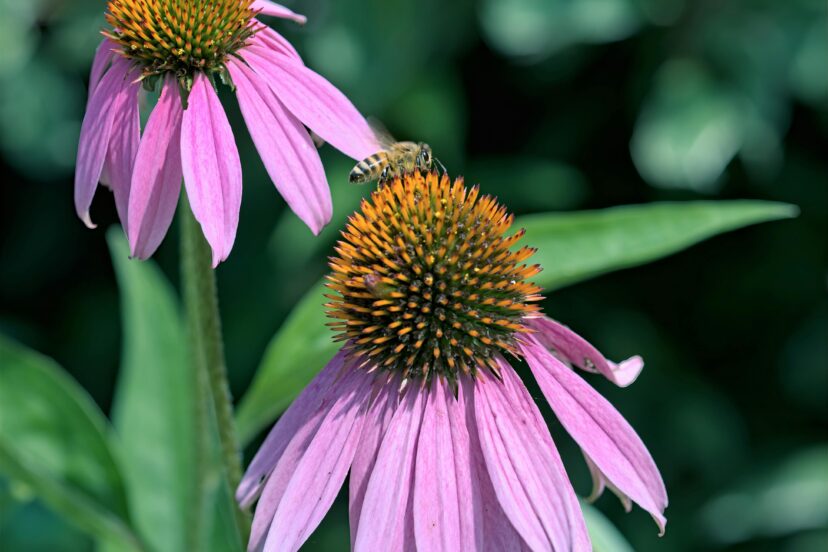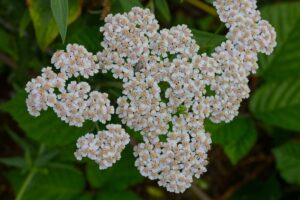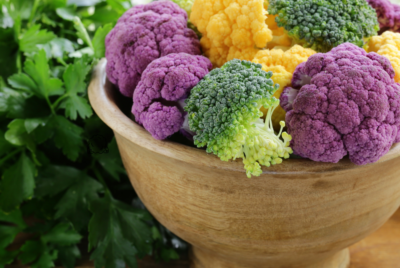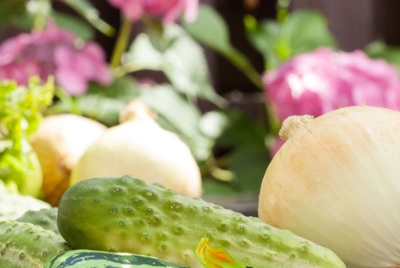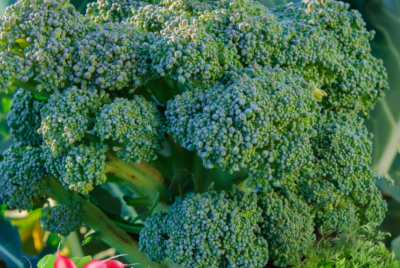Echinacea Companion Planting
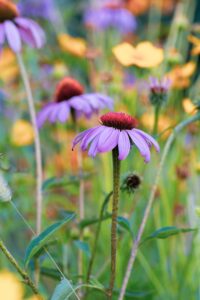
I.Introduction
1.Overview of Echinacea
Echinacea, commonly known as the purple coneflower, is more than just a staple in many gardens; it’s a plant rich in history and health benefits. Native to North America, Echinacea has long been celebrated for its vibrant blooms and medicinal properties. The benefits of Echinacea are manifold, including its use in boosting the immune system, reducing symptoms of colds and flu, and serving as an anti-inflammatory agent. The beauty of its purple-pink petals, which radiate around a spiky, cone-shaped center, makes it a favorite among gardeners and nature enthusiasts alike.
But there’s more to Echinacea than meets the eye. Its ability to enhance a garden’s ecosystem is significantly amplified when we delve into the practice of companion planting. Companion planting, an age-old agricultural practice, involves the strategic placement of different plants in close proximity for mutual benefit. This method can lead to enhanced growth, improved health, and better pest control. In the case of Echinacea, companion planting not only boosts the aesthetic appeal of your garden but also plays a vital role in promoting a healthy, thriving environment for all plants involved.
2.Importance of companion planting
The importance of companion planting with Echinacea lies in its ability to create a symbiotic relationship with its neighbors. This mutually beneficial arrangement can lead to a more resilient garden, where plants support each other’s growth and well-being. For instance, certain plants when grown alongside Echinacea can help in attracting beneficial insects, deterring pests, and even improving soil quality. This natural way of maintaining garden health reduces the need for chemical interventions, making your garden a haven for wildlife and a more sustainable environment overall.
In the subsequent sections, we will explore the best companion plants for Echinacea, how to avoid incompatible plants, and tips on maximizing the medicinal value of Echinacea through effective companion planting strategies. We will also delve into designing a companion plant garden, caring for Echinacea and its companions, and the broader impacts of this practice on the environment and biodiversity. So, whether you’re a seasoned gardener or just starting out, understanding the art of Echinacea companion planting will not only enhance the beauty of your garden but also contribute to a healthier, more vibrant ecosystem.
II. Understanding Echinacea
1.Description and characteristics
Echinacea, a genus of herbaceous flowering plants in the daisy family, is a group distinguished by its showy and distinct flowers. This plant is native to North America and can be identified by its characteristic features. The most recognizable species, Echinacea purpurea, typically boasts purple or pink petals that surround a central cone, usually orange or brown in color. This cone is not only a striking feature but also a hub of rich pollen, attracting bees and butterflies.
The physical characteristics of Echinacea vary across species, but common traits include tall stems ranging from 1 to 2 feet, lance-shaped leaves, and large, prominent flower heads. These plants are perennials, meaning they return year after year, and they thrive in hardiness zones 3 through 9. Echinacea prefers full sunlight but can tolerate partial shade, and it flourishes in well-drained soil.
2.Medicinal uses
Beyond its aesthetic appeal, Echinacea is renowned for its medicinal uses. Historically, Native Americans used it for various medicinal purposes, and today, it’s popularly used in herbal remedies worldwide. The roots and aerial parts of the plant are used to make teas, tinctures, capsules, and extracts. Echinacea is most commonly sought for its immune-boosting properties. It’s believed to enhance the body’s natural defense system, making it a popular supplement during cold and flu seasons. Studies suggest that Echinacea can reduce the severity and duration of cold symptoms, though findings are mixed and more research is needed to conclusively determine its efficacy.
Additionally, Echinacea has anti-inflammatory properties, making it beneficial in reducing symptoms related to various inflammatory conditions. It’s also used in skin care products for its healing properties, aiding in wound healing and skin regeneration. Its antioxidant properties further contribute to its health benefits, helping to combat oxidative stress.
In summary, Echinacea is not just a visually striking plant but also a powerhouse of medicinal benefits. Its ability to support the immune system, along with its anti-inflammatory and antioxidant properties, makes it a valuable addition to any garden. In the next sections, we’ll explore how to maximize these benefits through companion planting, ensuring your Echinacea thrives alongside other plants that complement its growth and medicinal properties.
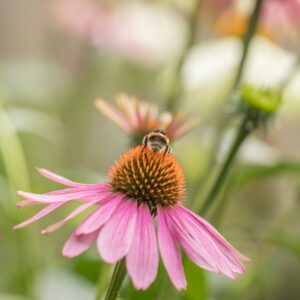
III. The Basics of Companion Planting
Companion planting is an age-old gardening practice that involves growing different plants in close proximity for mutual benefit. This method is based on the understanding that certain plants can positively influence the growth, health, and yield of others when planted together. The concept of companion planting is rooted in creating a diverse and harmonious garden ecosystem where plants interact in supportive ways.
1.Definition and Benefits
The benefits of companion planting are wide-ranging. One of the primary advantages is pest control. Certain plants can repel unwanted insects naturally, reducing the need for chemical pesticides. For example, some plants emit chemicals from their roots or leaves that repel pests, while others attract beneficial insects that prey on pests.
Companion planting also promotes healthier growth. Some plant combinations can enhance nutrient uptake. For instance, legumes fix nitrogen in the soil, which can be beneficial for nitrogen-loving plants planted nearby. This symbiotic relationship improves soil fertility and plant health.
Additionally, companion planting can optimize space and increase yield. Plants with different growth habits and requirements can be paired to make the most of available space. Tall plants can provide shade for sun-sensitive shorter plants, while deep-rooted plants can be grown alongside shallow-rooted ones to utilize different soil layers effectively.
Another benefit is disease prevention. The diversity in a companion-planted garden can prevent the spread of diseases. Certain plant combinations can be less susceptible to specific diseases, thus reducing overall disease incidence in the garden.
2.How Companion Planting Works
Companion planting works by taking advantage of the natural properties of plants and their interactions. Each plant species has its unique set of characteristics and can affect its surroundings in various ways. For instance, some plants may secrete substances through their roots or leaves that affect the growth of neighboring plants positively or negatively.
Moreover, companion planting often involves understanding the lifecycle and needs of different plants. It’s about creating a balance where the needs of one plant complement the strengths of another. For example, taller plants can provide shade and wind protection for smaller, more delicate species.
Companion planting also extends to the attraction of beneficial wildlife. Certain plants can attract pollinators like bees and butterflies, which are essential for the pollination of many crops. Others might attract predatory insects, which can help keep pest populations in check.
In essence, companion planting is a holistic approach to gardening. It involves understanding and harnessing the natural relationships between different plants to create a thriving, sustainable garden ecosystem. In the context of Echinacea, companion planting can enhance its growth and medicinal properties while contributing to the overall health and balance of the garden.
VI. Best Companion Plants for Echinacea
Echinacea thrives when surrounded by compatible companion plants that complement its growth habits and needs. Here’s a list of some of the best companion plants for Echinacea, along with descriptions and reasons for their compatibility:
1. Lavender (Lavandula)
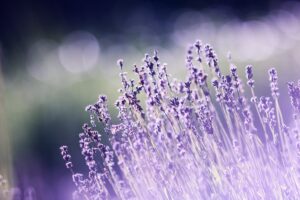
a. Description
Lavender is a fragrant perennial known for its soothing purple blooms.
b. Compatibility
Lavender’s strong scent is excellent for repelling deer and rabbits, which might otherwise nibble on Echinacea. It also attracts pollinators, enhancing the overall health of the garden.
2. Yarrow (Achillea millefolium)
Description
Yarrow is a hardy perennial with flat-topped flower clusters.
Compatibility
Yarrow attracts beneficial insects and pollinators while also improving soil quality. Its presence can enhance Echinacea’s growth and health.
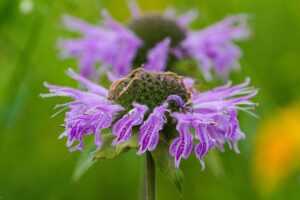
3. Bee Balm (Monarda)
Description
Bee Balm is a vibrant, aromatic herb known for its bright, spiky flowers.
Compatibility
It attracts bees and butterflies, which are vital for pollination. The proximity of Bee Balm can help increase Echinacea’s pollination rates.
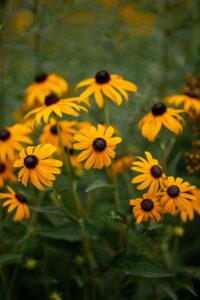
4. Black-Eyed Susan (Rudbeckia)
Description
Black-Eyed Susan is a cheerful, daisy-like flower with a dark center.
Compatibility
It shares similar growing conditions with Echinacea and can help create a visually appealing, staggered blooming period in the garden.
5. Switchgrass (Panicum virgatum)
Description
Switchgrass is a tall, native prairie grass with a robust, upright growth habit.
Compatibility
Its deep roots help improve soil structure, benefiting Echinacea. It also provides winter interest and habitat for beneficial insects.
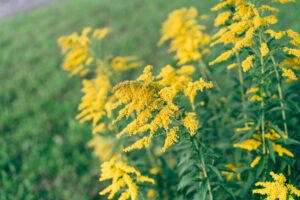
6. Goldenrod (Solidago)
Description
Goldenrod is known for its bright yellow flower spikes.
Compatibility
Goldenrod is a late bloomer, providing continued interest in the garden after Echinacea has finished blooming. It also attracts beneficial insects.
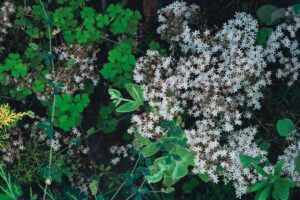
7. Sedum (Sedum spp.)
Description
Sedum is a group of succulents with thick, fleshy leaves and clusters of star-shaped flowers.
Compatibility
Sedum varieties offer late-season blooms and ground cover, complementing Echinacea’s growth cycle and providing a diverse habitat for pollinators.
8. Asters (Aster spp.)
Description
Asters are perennials with starry-shaped flowers, often blooming in shades of purple, blue, and white.
Compatibility
They bloom in late summer to fall, providing a succession of flowers after Echinacea. This staggered blooming helps maintain pollinator activity in the garden.
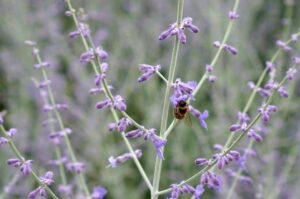
9. Russian Sage (Perovskia atriplicifolia)
Description
Russian Sage is a tall, airy perennial with lavender-blue flowers and silvery foliage.
Compatibility
It’s a drought-tolerant plant that can thrive in similar conditions as Echinacea. Its tall stature and long blooming period complement Echinacea’s growth.
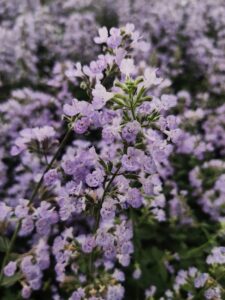
10. Catmint (Nepeta)
Description
Catmint is known for its fragrant, grey-green foliage and lavender-blue flowers.
Compatibility
It’s a great ground cover that helps suppress weeds. Catmint also attracts bees and butterflies, aiding in pollination.
Each of these plants offers unique benefits that can enhance the health, growth, and aesthetic appeal of Echinacea. By choosing the right companions, gardeners can create a vibrant, supportive, and sustainable garden ecosystem.
V. Avoiding Incompatible Plants
While companion planting can offer numerous benefits, it’s equally important to be aware of which plants are incompatible with Echinacea. Certain plants can hinder Echinacea’s growth or health due to their specific characteristics or requirements. Here’s a list of plants to avoid planting near Echinacea, along with the reasons for their incompatibility:
1. Walnut Trees (Juglans spp.)
Incompatibility
Walnut trees, including black walnuts, produce a chemical called juglone, which is toxic to many plant species, including Echinacea. This chemical, found in all parts of the walnut tree, can inhibit the growth or even kill sensitive plants.
2. Fennel (Foeniculum vulgare)
Incompatibility
Fennel is known to be allelopathic, meaning it can inhibit the growth of nearby plants through chemicals it releases into the soil. It’s not a good neighbor for Echinacea and can hinder its growth.
3. Cabbage and Related Crops (Brassicaceae family)
Incompatibility
This family includes broccoli, cauliflower, and Brussels sprouts. These plants can compete heavily with Echinacea for nutrients and space, potentially stunting its growth. They also attract different sets of pests, which could be detrimental to Echinacea.
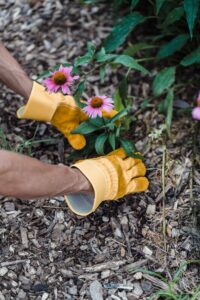
4. Rye Grass (Lolium spp.)
Incompatibility
Rye grass, especially when used as a cover crop, can be allelopathic like fennel. It can suppress the germination and growth of Echinacea through the chemicals it releases.
5. Sunflowers (Helianthus annuus)
Incompatibility
Sunflowers can be aggressive in their growth, competing for sunlight, water, and nutrients. This competition can be detrimental to Echinacea, especially smaller or younger plants.
6. Mint (Mentha spp.)
Incompatibility
While mint is generally beneficial for attracting pollinators, it’s an aggressive spreader and can quickly overtake a garden space. This aggressive growth can crowd out Echinacea and other plants.
7. Corn (Zea mays)
Incompatibility
Corn is a heavy feeder and can deplete the soil of nutrients needed by Echinacea. Additionally, corn’s tall stature can shade out Echinacea, impeding its access to sunlight.
Understanding and avoiding these incompatible plants is crucial for maintaining a healthy and thriving Echinacea garden. By ensuring that Echinacea is surrounded by compatible companions and not hindered by antagonistic plants, gardeners can create a harmonious and productive garden ecosystem.
VI. Maximizing Medicinal Value
Echinacea’s value in the garden extends beyond its ornamental appeal to its well-regarded medicinal properties. Understanding how companion planting affects these properties and implementing strategies to enhance them can lead to a more beneficial harvest.
1.How Companion Planting Affects Echinacea’s Medicinal Properties
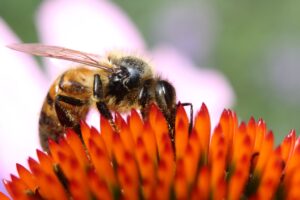
a. Improved Plant Health
Healthy plants produce higher quality phytochemicals, which are essential for their medicinal properties. Companion plants that improve soil quality or deter pests contribute to the overall health of Echinacea, potentially enhancing its medicinal value.
b. Stress Reduction
Plants, like Echinacea, that are under less stress from pests and disease, or from competing for resources, can allocate more energy towards developing medicinal compounds. Companion plants that provide these benefits indirectly boost the medicinal quality of Echinacea.
c. Biodiversity and Resilience
A diverse garden ecosystem, fostered by companion planting, can lead to more resilient plants. Echinacea grown in a biodiverse setting may have a better phytochemical profile compared to those grown in monoculture.
2.Tips for Enhancing Medicinal Quality
a. Choose the Right Companions
Incorporate companion plants that enhance soil nutrients, especially those that add organic matter or fix nitrogen. Plants like yarrow and lavender can also help by attracting beneficial insects that control pests naturally.
b. Harvest Timing
The medicinal compounds in Echinacea are most potent when the plant is in the early stages of flowering. Harvesting at this time ensures the highest concentration of active ingredients.
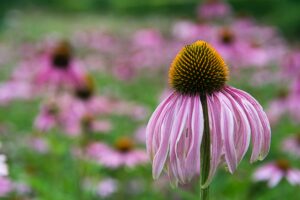
c. Optimal Growing Conditions
Ensure Echinacea is planted in a location with full sun and well-drained soil. These conditions are essential for the plant to develop its medicinal compounds fully.
d. Organic Practices
Avoid synthetic chemicals and pesticides in the garden. These can not only harm beneficial insects and soil health but also may reduce the medicinal quality of Echinacea.
e. Regular Pruning and Maintenance
Pruning the plants around Echinacea ensures it receives enough sunlight and air circulation, reducing the risk of fungal diseases and promoting healthy growth.
f. Soil Health
Regularly adding organic matter and ensuring a balanced pH can enhance the growth and medicinal properties of Echinacea. Healthy soil contributes to the overall health of the plant.
g. Water Management
While Echinacea is drought-tolerant, consistent watering during dry spells can prevent stress and support the development of medicinal properties.
By following these tips and understanding the relationship between companion planting and Echinacea’s medicinal properties, gardeners can maximize the health benefits of this remarkable plant. Companion planting not only enriches the garden visually and ecologically but can also play a significant role in enhancing the medicinal qualities of Echinacea.
VII. Designing Your Companion Plant Garden
Creating a companion plant garden that includes Echinacea requires thoughtful planning, both for aesthetics and practicality. A well-designed garden maximizes the benefits of companion planting while also ensuring your garden is a visually pleasing space. Here are some layout and spacing considerations, along with aesthetic and practical tips:
1.Layout and Spacing Considerations
a. Sunlight and Shade
Echinacea loves full sun, so place it in a part of your garden that receives ample sunlight. Arrange companion plants according to their sun requirements, ensuring that taller plants don’t overshadow sun-loving shorter companions.
b. Plant Height and Structure
Consider the mature height of your plants. Place taller plants like sunflowers or switchgrass at the back of beds or in the center of island beds, with shorter plants like lavender and sedum in front or around them. This tiered approach ensures all plants are visible and receive adequate sunlight.
c. Root Space
Some plants have deep roots, while others have shallow roots. Plant deep-rooted companions like
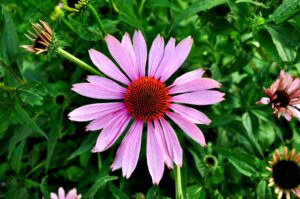
switchgrass at sufficient distances from Echinacea to prevent competition for nutrients and water.
d. Spacing for Air Circulation
Good air circulation is vital for preventing disease. Space plants according to their mature size, ensuring there’s enough room between them for air to flow freely.
2.Aesthetic and Practical Tips
a. Color Coordination
Echinacea’s purple-pink flowers pair beautifully with a variety of colors. Plant them near yellows (like black-eyed Susan), blues (such as lavender), or whites (like Shasta daisies) for a vibrant display.
b. Texture Variety
Mix plants with different textures for visual interest. The spiky leaves of yarrow or the soft, round foliage of sedum can contrast nicely with Echinacea’s coarse leaves and bold flowers.
c. Seasonal Interest

Choose companions that bloom at different times to ensure continuous color in your garden. For instance, pair Echinacea with late-blooming asters or early-blooming catmint.
d. Accessibility for Maintenance and Harvesting
Ensure that all plants are easily accessible for maintenance, especially Echinacea, if you plan to harvest it for medicinal purposes. Create pathways or allow enough space between plants for easy access.
e. Mulching and Ground Cover
Use mulch or ground-cover plants like sedum to maintain soil moisture, suppress weeds, and add to the garden’s aesthetic appeal.
f. Attracting Wildlife
Incorporate plants that attract beneficial insects and birds. Lavender and bee balm are great for attracting bees and butterflies, while sunflowers can draw birds.
g. Harmonious Grouping
Group plants with similar water and fertilizer needs together. This ensures all plants in a particular section of your garden get the right amount of nutrients and water, without over- or under-doing it for some.
Designing your companion plant garden with these considerations in mind will not only create a beautiful and thriving garden but also a practical and sustainable space. The goal is to balance the needs and benefits of each plant, including Echinacea, to create a harmonious, healthy garden ecosystem.
VIII Caring for Your Echinacea and Its Companions
Proper care is essential to ensure that your Echinacea and its companion plants thrive. Understanding their needs in terms of watering, soil, sunlight, pest control, and disease prevention is key. Here’s a guide to help you provide the best care for your Echinacea garden.
1.Watering, Soil, and Sunlight Needs
a. Watering
Echinacea is relatively drought-tolerant once established, but it does need regular watering during its first growing season to establish a strong root system. Provide about an inch of water weekly, but be mindful of the water needs of its companions as well. Over-watering can lead to root rot, so ensure good drainage in the soil.

b. Soil
Echinacea thrives in well-drained soil rich in organic matter. A pH between 6.0 and 7.0 is ideal. Enhance your soil with compost or organic matter to ensure it has the necessary nutrients. Again, consider the soil preferences of companion plants and aim for a balance that supports all species in your garden.
c. Sunlight
This plant requires full sun for optimal growth and flowering. Ensure that it gets at least 6-8 hours of direct sunlight daily. If companion plants have different light requirements, position them accordingly to ensure they all get the necessary sunlight without overshadowing each other.
2.Pest Control and Disease Prevention
a. Pest Control
Echinacea can attract aphids and Japanese beetles. Introducing natural predators like ladybugs or planting garlic and chives nearby can help control these pests. Avoid using chemical pesticides, as they can harm beneficial insects and the overall ecosystem of your garden.
b. Disease Prevention
Echinacea can be prone to fungal diseases like powdery mildew, especially in humid conditions or if there’s poor air circulation. To prevent this, space plants properly and avoid overhead watering. If necessary, use organic fungicides, and remove any affected parts of the plant to prevent the spread of disease.
c. Companion Plant Health
Monitor the health of companion plants regularly. Some, like lavender or rosemary, require less water and more drainage, while others like yarrow may be more prone to pests. Adjust care as necessary, considering the needs of the entire garden ecosystem.
d. Mulching
Apply a layer of mulch around the plants to conserve soil moisture, regulate soil temperature, and suppress weed growth. Organic mulch can also add nutrients to the soil as it decomposes.
e. Regular Maintenance
Regularly deadhead Echinacea and its companions to encourage more blooms and prevent self-seeding where not desired. Also, cut back Echinacea in late fall or early spring to promote healthy growth and prevent overcrowding.
By paying attention to these care aspects, you can ensure that your Echinacea and its companion plants grow healthily and display their full beauty and benefits. Remember, a little observation and regular maintenance can go a long way in maintaining a vibrant and thriving garden.
IX. Seasonal Considerations
Caring for Echinacea and its companion plants involves adjusting your gardening practices according to the different seasons. Each season brings its unique set of challenges and opportunities for garden maintenance. Here’s how you can adapt your care routine throughout the year, with a special focus on preparing for winter.
1.Spring
a. Planting and Replanting
Early spring, after the last frost, is an ideal time to plant Echinacea and its companions. If you’re dividing or transplanting established Echinacea, this is also the best time to do it.
b. Soil Preparation
Enrich the soil with compost or organic matter to give your plants a nutrient boost for the growing season.
Pruning and Cleanup: Clear away any dead foliage from the previous year, and prune any damaged or diseased parts of the plant.

2.Summer
a. Watering
As the weather gets warmer, ensure consistent watering, especially if there are prolonged dry spells. Early morning watering is best to reduce evaporation and prevent fungal diseases.
b. Mulching
Apply a fresh layer of mulch to conserve moisture, suppress weeds, and keep the roots cool.
c. Monitoring for Pests and Diseases
Keep an eye out for signs of pests or diseases and address them promptly with organic solutions.
d. Deadheading
Regularly deadhead spent Echinacea blooms to encourage continued flowering.
3.Fall (Autumn)
a. Preparing for Dormancy
Reduce watering as the plants start to die back in preparation for winter dormancy.
b. Final Harvest
If you use Echinacea for medicinal purposes, complete your final harvest before the first frost.
c. Soil Maintenance
It’s a good time to add amendments like bone meal or rock phosphate to the soil to prepare for the next growing season.
d. Plant Protection
For more tender companion plants, consider adding extra mulch or protective coverings to insulate them from the cold.
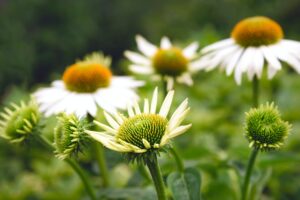
4.Winter
Winter Care for Echinacea
Echinacea is quite hardy and usually survives winter without much trouble. However, in very cold climates, a layer of mulch can help protect the roots.
a. Pruning
You can choose to leave the dried Echinacea stalks and heads over winter, as they provide food for birds and add winter interest to the garden. Alternatively, prune them back to the ground to keep your garden tidy.
b. Checking Perennial Companions
Some perennials may need extra protection in the form of mulch or burlap, especially in regions with harsh winters.
c. Planning for Spring
Winter is a great time to plan any changes or additions to your garden for the upcoming year.
Adjusting your gardening practices according to these seasonal needs will ensure that your Echinacea and companion plants remain healthy and vibrant throughout the year. Preparing properly for winter is especially crucial, as it sets the stage for successful growth in the spring.
X. Harvesting and Utilizing Echinacea
Echinacea is not just a beautiful addition to your garden; it’s also a valuable medicinal herb. Knowing when and how to harvest Echinacea, along with understanding its various uses, can enhance your gardening experience and provide health benefits. Here are some best practices for harvesting Echinacea and different ways to utilize it.
1.Best Practices for Harvesting
a. Timing
The best time to harvest Echinacea roots is in the fall, after the flowering period is over and the plant has had three to four years to develop fully. For the aerial parts like leaves and flowers, harvest them when the plant is blooming, usually in the mid to late summer.
b. Method
When harvesting roots, dig around the plant carefully, ensuring you don’t damage the root system excessively. Shake off the excess soil and rinse the roots with water. For leaves and flowers, use clean, sharp shears to snip off the parts you need.
c. Drying
After harvesting, the roots, leaves, and flowers need to be dried. Lay them out in a warm, airy space out of direct sunlight. The drying process can take several days, and it’s essential to ensure they’re completely dry to prevent mold.
d. Storage
Once dried, store the Echinacea parts in airtight containers, away from direct sunlight and moisture. Properly dried and stored Echinacea can last for several years.
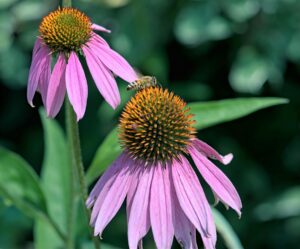
2.Ways to Use Echinacea
a. Tea
One of the most common uses of Echinacea is to brew it into a tea. Both the dried roots and aerial parts can be used. Echinacea tea is popular for immune system support, especially during cold and flu season.
b. Tinctures
Echinacea tinctures are concentrated herbal extracts. You can make your own by soaking the dried plant parts in alcohol. Tinctures are taken in small doses and are believed to be more effective in delivering the herb’s benefits.
c. Topical Applications
Echinacea can be used in creams or ointments for skin care. Its anti-inflammatory properties make it beneficial for treating wounds, eczema, and other skin irritations.
d. Capsules and Supplements
Dried Echinacea can be ground into a powder and used to make capsules. This is a convenient way to take Echinacea, especially for those who don’t enjoy the taste of the tea.
e. Culinary Uses
While not as common, Echinacea petals can be used as a garnish or in salads for a subtle flavor and a burst of color.
f. Decorative
Dried Echinacea flowers can also be used in floral arrangements or as part of herbal wreaths, bringing a bit of your garden’s beauty indoors.
Incorporating Echinacea into your wellness routine or using it in various applications around the home can be a rewarding way to benefit from your garden’s bounty. Remember, if you’re using Echinacea for medicinal purposes, it’s always wise to consult with a healthcare professional, especially if you have existing health conditions or are taking other medications
XI. The Broader Impact of Companion Planting
Companion planting, as practiced in gardens with plants like Echinacea, extends its benefits far beyond the boundaries of individual gardens. This approach to gardening plays a significant role in promoting environmental sustainability and enhancing biodiversity. Understanding these broader impacts can deepen our appreciation for this age-old practice.
1.Environmental Benefits
a. Reduced Need for Chemicals
Companion planting, as practiced in gardens with plants like Echinacea, extends its benefits far beyond the boundaries of individual gardens. This approach to
planting naturally reduces the need for chemical pesticides and fertilizers. Plants like Echinacea, when paired with the right companions, can deter pests and improve soil nutrients, thereby reducing reliance on harmful chemicals. This leads to a healthier environment and contributes to the well-being of the surrounding ecosystem.
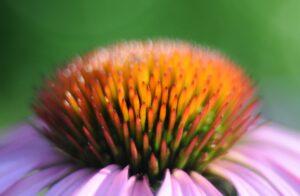
b. Improved Soil Health
Companion planting encourages a diverse range of plants to grow together, which can lead to improved soil structure and health. Different plants contribute various organic materials to the soil, enhancing its fertility and reducing the need for synthetic soil amendments.
c. Water Conservation
Certain companion planting strategies can help in efficient water use. For example, using ground cover plants can reduce water evaporation from the soil, and the strategic placement of plants can reduce runoff, ensuring that more water is absorbed where it’s needed.
d. Carbon Sequestration
Plants naturally capture carbon dioxide from the atmosphere. A diverse garden with a variety of plants, like one employing companion planting, can sequester more carbon, contributing to the mitigation of climate change.
2.Contribution to Biodiversity
a. Habitat for Wildlife
A garden rich in diverse plants offers a variety of habitats for different wildlife species. Companion planting with Echinacea and other species creates an environment that attracts and supports a range of insects, birds, and other animals.
b. Supporting Pollinators
Many companion plants, including Echinacea, are excellent at attracting pollinators like bees, butterflies, and hummingbirds. These pollinators are crucial for the reproduction of many plants and the overall health of ecosystems.
c. Preservation of Plant Varieties
Companion planting often involves the use of heirloom and non-commercial plant varieties. This practice helps in preserving genetic diversity among plant species.
d. Creating Micro-Ecosystems
Each companion-planted garden acts as a small ecosystem, contributing to the larger ecological network. These micro-ecosystems help in maintaining ecological balance, especially in urban and suburban areas where green spaces are limited.
In summary, the practice of companion planting, exemplified in gardens with Echinacea and its companions, has far-reaching impacts on environmental health and biodiversity. It’s a sustainable approach that not only enhances the beauty and productivity of gardens but also contributes significantly to the well-being of our planet. As gardeners, adopting companion planting is a small but meaningful step towards creating a more sustainable and ecologically balanced world.
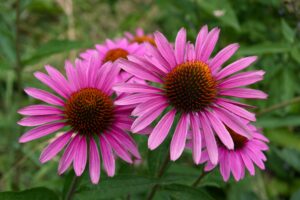
XII. Conclusion
The journey through the world of Echinacea companion planting reveals much more than just the practicalities of gardening. It’s a testament to the interconnectedness of nature and the profound impact we can have through mindful gardening practices. Echinacea, with its striking beauty and medicinal properties, serves as a perfect example of how a single plant can enrich our gardens, improve our health, and contribute to the health of the environment.
Companion planting with Echinacea is not just about creating visually appealing garden spaces; it’s an approach that embodies sustainability, ecological awareness, and a deeper understanding of the symbiotic relationships in nature. By choosing the right companion plants, we enhance the growth and medicinal qualities of Echinacea, while also fostering a garden that supports biodiversity, promotes soil health, conserves water, and reduces the need for chemicals.
This guide has covered the essentials of caring for Echinacea and its companions, from the basics of companion planting to the specific needs for each season, and from harvesting and utilizing Echinacea to understanding its broader environmental impact. The practice of companion planting with Echinacea is a beautiful blend of art and science, offering a fulfilling and enriching experience for gardeners of all levels.
In conclusion, embracing the principles of companion planting with Echinacea can lead to a garden that is not only a source of beauty and health but also a contributor to the well-being of our planet. It’s a step towards more sustainable living, where each plant, each garden, plays a role in a larger ecological narrative. So, whether you’re a seasoned gardener or a beginner, let the journey of companion planting with Echinacea inspire you to create garden spaces that are thriving, sustainable, and in harmony with nature.
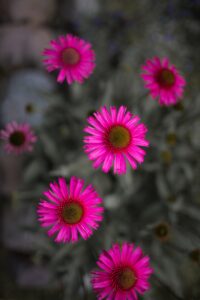
FAQs
1.What are the best companion plants for Echinacea?
Answer: The best companions for Echinacea include lavender, which repels pests with its scent; yarrow, attracting beneficial insects; bee balm and black-eyed Susan, both enhancing garden biodiversity; and goldenrod, extending the blooming season. These plants not only support Echinacea’s growth but also contribute to a vibrant garden ecosystem.
2. Can I use Echinacea for medicinal purposes from my garden?
Answer: Yes, you can use garden-grown Echinacea for medicinal purposes. It’s best to harvest the roots after 3-4 years or the aerial parts during flowering for maximum potency. You can use these parts to make teas, tinctures, or topical applications, which are popular for immune support and skin care.
3. How do I care for Echinacea throughout the seasons?
Answer: Care for Echinacea involves providing full sun and well-drained soil, regular watering, especially during dry spells, and spacing for good air circulation. In spring, enrich the soil and prune dead foliage. Reduce watering in fall and add mulch for winter protection. Also, monitor for pests and diseases, addressing them with organic solutions.
4. What should I avoid when companion planting with Echinacea?
Answer: Avoid planting Echinacea near allelopathic plants like walnut trees and fennel, which can inhibit its growth. Also, steer clear of heavy feeders like corn and aggressive spreaders like mint, which can compete for resources or overshadow Echinacea.
5. How does companion planting with Echinacea benefit the environment?
Answer: Companion planting with Echinacea reduces the need for chemicals, improves soil health, conserves water, and helps in carbon sequestration. It also creates habitats for wildlife, supports pollinators, preserves plant diversity, and contributes to creating balanced micro-ecosystems, enhancing overall environmental health.

Companion Planting for Cauilflower
Companion Planting for Asparagus

